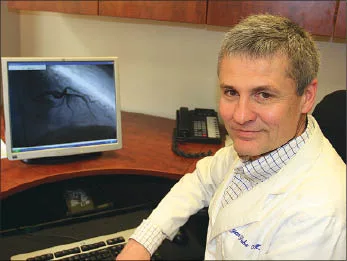Angioplasty takes a shortcut through the wrist
Spokane Cardiology does procedure here in growing number of heart patients

In a growing number of cases, the best route to a blocked coronary artery starts at the wrist rather than the groin.
Dr. Bryan Fuhs, co-director of preventive care with Spokane Cardiology PS, says that physicians group is performing wrist-access coronary angioplasty on an increasing number of patients. The procedure was developed in the 1990s, but only recently has begun to gain in popularity in the U.S., Fuhs says.
"From the start of a good idea, it takes eight to 10 years for adoption," he says. "I've been hearing more and reading more about it the last couple of years."
The most common approach to angioplasty involves inserting a catheter into the femoral artery at the groin and snaking it through blood vessels to the site of blockages in arteries that provide blood flow to the heart.
Angioplasty via the radial artery, which is accessed at the wrist, has become practical with the development of smaller catheters to treat blockages, Fuhs says. The diameter of the radial artery is generally less than half the diameter of the femoral artery. A typical catheter used in the wrist approach is about 2 millimeters in diameter, or roughly the width of an uncooked spaghetti noodle—although some catheters can be half that thickness.
More than 1 million heart angioplasties are performed in the U.S. each year, says the U.S. Department of Health and Human Services. As of 2007, only about 1 percent of U.S. coronary angioplasties were performed through the wrist.
Fuhs says physicians at Spokane Cardiology perform about 1,000 to 1,500 heart angioplasties annually. Of those, more than 3 percent are done via the radial artery, a rate that he thinks will only increase in coming years.
"I think in 10 to 15 years, 50 percent of the procedures will be done via the radial artery," he says.
Most of the group's angioplasty procedures are conducted at Deaconess Medical Center, although Spokane Cardiology has its own cath lab at its main office in the Deaconess Health & Education Center building next to the hospital. Spokane Cardiology, a group of 17 physicians, operates five offices in the Inland Northwest.
Fuhs, one of the early adopters of the wrist approach to coronary angioplasty, now hands most such cases over to three other physicians at Spokane Cardiology, who are among a handful of Spokane-area cardiologists who perform the procedure via the wrist.
Fuhs says that although only about 1 percent of angioplasties approached through the femoral artery result in complications, a growing body of data, much of it gathered in the last two years, indicates that treating blocked coronary arteries via the wrist is safer and easier on some patients.
For example, a report presented last month at the International Symposium on Endovascular Therapy, in Hollywood, Fla., says the wrist approach results in lower cost, less time before the patient can get up and walk, and fewer complications. Findings in the report are drawn from data on more than 5,000 procedures performed at Baptist Cardiac & Vascular Institute, in Miami.
The puncture site in the wrist procedure is less prone to bleeding than the puncture site at the groin, Fuhs says.
"With a wrist, you can put a finger on it and stop it," he says.
Stopping bleeding at the groin site involves a variety of tools, including items that look like sandbags and oversized C-clamps, to maintain pressure on the puncture site until it seals.
Patients undergoing the femoral approach must lie still for at least four hours after the procedure to help the puncture site seal, Fuhs says.
Those who undergo the wrist procedure are encouraged to sit up as soon as they are able and can be on their feet again in a couple of hours, he says.
The two approaches are equally effective in treating coronary blockages, Fuhs says. In both techniques, a soft wire is threaded through blood vessels to the blockage. The catheter is then slipped over the wire and positioned at the blockage. A tiny balloon is inflated to open the vessel and restore blood flow at the site of the blockage. In some cases, a mesh tube called a stent is left behind to hold the vessel open.
The wrist procedure is gaining increasing interest from physicians whose patients take blood thinners, such as Coumadin, which commonly is prescribed to prevent blood clots in veins and arteries to reduce the risk of heart attack or stroke.
Some patients who undergo the femoral approach would be required to stop taking blood thinners prior to the procedure to avoid excess bleeding.
"In some cases, it's easier to go through the wrist than to interrupt a Coumadin regimen," Fuhs says.
Primary candidates for the wrist approach are patients with diseased or damaged leg arteries, and those who are obese, in which case the femoral artery is more difficult to locate and access.
Fuhs says other candidates are people with certain forms of arthritis.
"They aren't thrilled about lying still for four hours," he says.
The wrist procedure, however, could be performed on about 75 percent of the people who undergo coronary angioplasties, he says.
Patients who aren't candidates for the wrist procedure typically are those who are more than 80 years old or less than 5 feet 2 inches tall, because their radial arteries could be too small in diameter at the wrist to tolerate an angioplasty catheter, he says.
Fuhs says the main reason more angioplasties aren't performed via the wrist is that comparatively few physicians are trained to do it.
"It takes 100 to 300 cases to be proficient," he says.
Once a physician is experienced in the wrist approach, the procedure generally doesn't take any longer to perform than it does via the groin, Fuhs says, although the wrist approach isn't recommended in cases of emergency that might require a physician to use the larger femoral artery.
Fuhs anticipates that more training programs will be offered in coming years to meet growing interest in the procedure.
Related Articles


_c.webp?t=1763626051)

_web.webp?t=1764835652)
